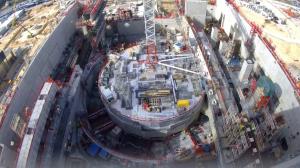Construction webcam
The world is watching
4 Mar 2019
-
Kirsten Haupt
Thousands of people from all over the world are monitoring the progress of ITER construction via live stream camera. Fixed to the highest point of the Assembly Building, the camera provides a perfect vantage point for following activities in the Tokamak Building below—24 hours a day, 7 days a week.
There is worldwide interest in viewing progress at ITER in real time. Since the webcam's installation in 2017, more than 20,000 web visitors from 140 countries have "watched" ITER construction from above.
Since August 2017, anyone can join in for a real-time update of construction work by following the "ON AIR" tab on the homepage of the ITER website. ITER has worked with the British company Site-Eye Time-Lapse for its specialized HD video stream technology—a combination of real-time and time-lapse—for the installation of a live stream camera above the Tokamak Complex.
The interest in following ITER construction activities in real time is high and global. Since the camera's installation, more than 20,000 web visitors from 140 countries have opened the live stream for a total of 160,000 virtual visits to the ITER worksite.
The attraction of the real-time webcam coverage is naturally strong in the ITER Members, and China, Europe, India, Japan, Korea, Russia and the United States account for the vast majority of traffic. But about one-tenth of viewers come from non-Member countries, with visits recorded from Venezuela, Nepal, Mauritius and Zambia to name a few.
In addition to the live stream viewing, Site-Eye also provides time-lapse films of construction activities at the Tokamak Building. One of the construction highlights captured last year was the lifting of the bioshield's temporary roof in March 2018 (see video here).
In the coming months, the company will install cameras to capture major assembly-phase milestones such as the start of work on the cryostat upper cylinder in the Cryostat Workshop, or the arrival of the first vacuum vessel sector in the Assembly Building.


